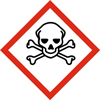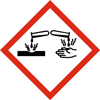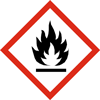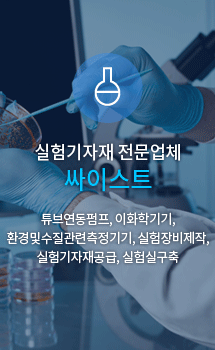안내사항 |
현재 홈페이지에 등록된 제품들은 재고 유무와 관계없이 구입이 가능하며, 별도문의의 상품인 경우 반드시 유선상 확인 후 구매부탁드립니다.
납기가 표기된 상품의 경우 일반적인 수입진행에 소요되는 기간이며, 상품에 따라 납기일정이 추가 될 수 있으니 참고부탁드립니다. |

Di-tert-butyl dicarbonate, 97+%
Description
Chemical Properties
· Formula : C10H18O5
· Formula weight : 218.25
· Melting Point : 21-24°
· Boiling Point : 56-57°/0.5mm
· Flash point : 37°(99°F)
· Density: 0.950
· Refractive Index: 1.4090
· Sensitivity: Keep Cold. Moisture Sensitive. Store under Nitrogen.
· Form: Low melting solid
· Solubility: Miscible with decalin, toluene, carbon tetrachloride, tetrahydrofuran, dioxane, alcohols, acetone, acetonitrile and dimethylformamide. Immiscible with water.
Literature References
Reagent for amino group protection as the tert-butyl carbamate (tert-butoxycarbonyl, Boc derivatives), in high yield under mild conditions, widely used in peptide chemistry; see Appendix 6. For practical details, literature references and tabulated results, see: Org. Synth. Coll., 7, 70 (1990). For further examples see: Synthesis, 223 (1987): Org. Synth. Coll., 9, 124, 300 (1998). Benzyl carbamates (Cbz, Z) may be transformed into Boc in a one pot procedure catalyzed by Pd/C: Tetrahedron Lett., 33, 3167 (1992).
Rapid and efficient formation of Boc derivatives of amines, catayzed by Copper(II) tetrafluoroborate hexahydrate, 26127 has been described: Tetrahdron Lett., 47, 1087 (2006).
For Boc protection of phenols, alcohols, thiols etc. under phase-transfer conditions, see: Can. J. Chem., 63, 153 (1985).
Amides can be protected in the presence of a catalytic quantity of DMAP (4-(Dimethylamino)pyridine, A13016): J. Org. Chem., 48, 2424 (1983); Acta Chem. Scand. B, 40, 745 (1986); the amide link of the product undergoes facile alkaline hydrolysis or methanolysis. The nitrogen function of indoles and pyrroles can also be protected under similar conditions: J. Chem. Soc., Chem. Commun., 1699 (1984); Org. Synth. Coll., 9, 121 (1998). 1-Boc indoles may be synthesized from N-Boc 2-alkylanilines: Synthesis, 871 (1991).
The Boc group is readily cleaved with acid, most often Trifluoroacetic acid, L06374.
In the presence of 1 equivalent of DMAP in acetonitrile, arylamines are converted to isocyanates, generally in high yield; the dicarbonate here behaves as a convenient phosgene replacement: Angew. Chem. Int. Ed., 34, 2497 (1995). The same reagent system has also been applied to nitroalkanes for the ambient temperature generation of nitrile oxides which were trapped in situ with dipolarophiles: Synthesis, 309 (1997). Carboxylic acids can be esterified in the presence of a catalytic amount of DMAP: Synlett, 263 (2004).
Carboxylic acids have also been converted to Boc-protected amines, via a one-pot Curtius rearrangement, using the reagent in the presence of sodium azide, with catalytic amounts of TBAB and zinc triflate: Org. Lett., 7, 4107 (2005).
For a brief feature on uses of the reagent in synthesis, see: Synlett, 1995 (2001).
Applications
Reagent for the introduction of the Boc protecting group.Di-tert-butyl dicarbonate is a reagent used for the introduction of BOC protecting group. It plays an important role in the preparation of 6-acetyl-1,2,3,4-tetrahydropyridine by reacting with 2-piperidone. It serves as a protecting group used in solid phase peptide synthesis.
Notes
Store in a cool place. Keep the container tightly closed in a dry and well-ventilated place. Moisture and light sensitive. Incompatible with oxidizing agents, reducing agents, bases and acids.
Other References:
· Beilstein : 1911173
· UN# : UN2930
GHS Hazard and Precautionary Statements
Hazard Statements : H330-H315-H317-H335-H318-H228
Fatal if inhaled.Causes skin irritation.May cause an allergic skin reaction.May cause respiratory irritation.Causes serious eye damage.Flammable solid.
Precautionary Statements : P280-P305+P351+P338-P302+P352-P304+P340-P310
Wear protective gloves/protective clothing/eye protection/face protection.IF IN EYES: Rinse cautiously with water for several minutes.
Remove contact lenses, if present and easy to do. Continue rinsing.
IF ON SKIN: Wash with plenty of soap and water.
IF INHALED: Remove to fresh air and keep at rest in a position comfortable for breathing.Immediately call a POISON CENTER or doctor/physician.



위험 및 안전 코드
위험 문구 : 11-26-37/38-41-43
Highly flammable.Very toxic by inhalation.Irritating to respiratory system and skin.Risk of serious damage to eyes.May cause sensitization by skin contact.
안전 문구 : 9-26-28-36/37/39-45-60
Keep container in a well-ventilated place.In case of contact with eyes, rinse immediately with plenty of water and seek medical advice.After contact with skin, wash immediately with plenty of ... (to be specified by the manufacturer).Wear suitable protective clothing, gloves and eye/face protection.In case of accident or if you feel unwell, seek medical advice immediately (show the label where possible).This material and its container must be disposed of as hazardous waste
· TSCA : 예
· RTECS : HT0230000












